The SAS Certified Data Integration Developer for SAS 9 exam steps a candidate’s ability to use data integration development knowledge and skills in a SAS environment. It also looks at how well you learn how to define the SAS Business Analytics platform’s architecture, create metadata for source and target data, generate metadata for target data and tasks, and work with changes, tables, and table loader transforms.
What Is SAS Data Integration Developer Exam?
The Data Integration Developer exam is a certification exam offered by SAS, a leading analytics software and services provider. The Certified Data Integration Developer exam tests a professional’s understanding and skills using SAS Data Integration Studio, a tool for extracting, transforming, and loading data.
The Data Integration Developer exam typically covers topics such as:
- Overview
- Creating Metadata for Source and Target Data
- Creating Metadata for Target Data and Jobs
- Working with Transformations
- Working with Tables and the Table Loader Transformation
- Working with Slowly Changing Dimensions
- Defining Generated Transformations
- Deploying Jobs
- In Database Processing
The SAS Certified Data Integration Developer exam format is typically multiple-choice, and the duration is around 105 minutes.
Passing the Certified Data Integration Developer exam demonstrates that a professional has the knowledge and skills to use SAS Data Integration Studio to extract, transform, and load data. This can be a valuable asset for data management and analytics professionals, as it can help them improve their skills, advance their careers, and increase their earning potential.
Why Is Data Integration Important?
- Businesses must constantly re-assess and refine the foundation of their organization to stay afloat. Competition is heated, and relying on inefficient operational activities can ultimately lead to the downfall of a company.
- Every scaling business must be prepared to work with large and complex data sets. Cohesively organizing this data is beneficial.
- Business applications depend on data every day across all departments. Order invoices, product inventory, and supply chain logistics are some examples where you might recognize data’s integral nature.
- Advanced analytics and refined management processes are only a few benefits that successful data integration can elicit. But it should be clear why data integration is paramount.
- Data Integration Developer is the process of combining data from multiple sources into a single repository. This lets businesses have a single view of their data, which can be used for reporting and analysis. Data integration can be achieved manually or through the use of the software.
- Data integration is a critical part of any business. It allows companies to have a single view of their data, which can be used for reporting and analysis. Data integration can be performed manually or through the use of software. Data integration has many benefits, including the ability to make better decisions, the ability to save time and money, and the ability to enhance customer satisfaction.
Benefits of SAS Data Integration Developer Certification
SAS Data Integration Developer certification shows a professional’s proficiency in using SAS Data Integration Studio to extract, transform, and load data.
Some benefits of obtaining this Data Integration Developer certification include the following:
- It recognizes your expertise in using SAS Data Integration Studio, a widely used tool in the data management industry.
- It can increase your job prospects and earning potential, as employers may prefer to hire certified professionals.
- It can aid you in staying current with the latest features and best practices of SAS Data Integration Studio, as the certification requires ongoing education and recertification.
- It can give you a competitive edge in the job market, as it shows your commitment to professional development and your ability to work with a powerful tool for data integration.
Looking for a Data Integration Developer?
The most significant obstacle integration projects face stems from cookie-cutter methods to data integration. Often, source systems differ from your unique business system, and enterprise data warehouses and mainstream cloud environments only sometimes consider every business unit’s nuances and custom integration requirements.
Finding a fully complete data integration platform can be difficult.






